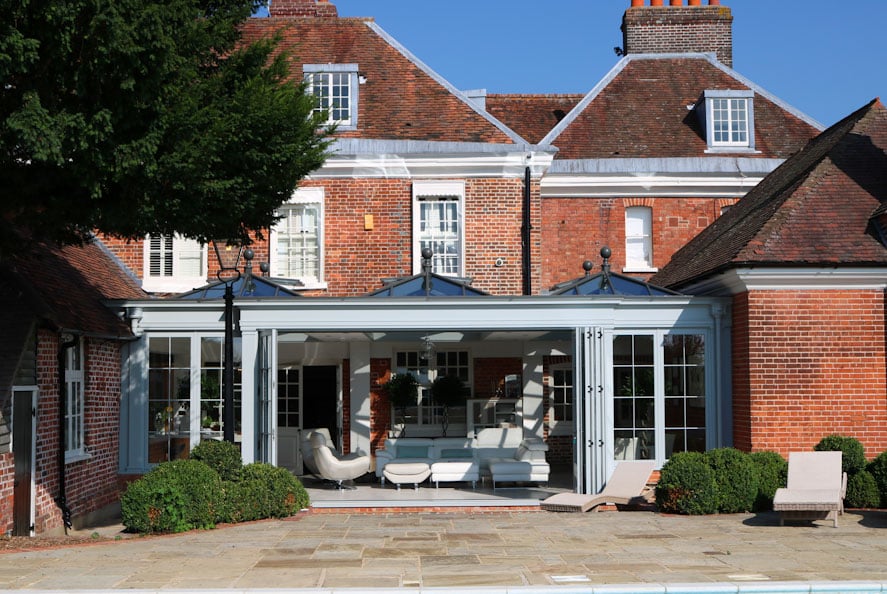Designing a bespoke conservatory for your property is incredibly exciting but if you’ve only just decided to add this type of glazed extension to your home, then you’ll undoubtedly have a number of questions. You’re in good company!
Here we’ve selected some of the most commonly-asked questions to help you get a better understanding of what’s involved.
1. Why is a conservatory called a conservatory?
It’s possible that conservatories were first built in Rome and therefore appropriately the name is derived from the Italian for ‘conservato’ meaning preserved.
Unsurprisingly, the first conservatories in the UK were designed by wealthy landowners and by the mid 19th century the English love of gardening meant these structures became increasingly popular – especially as the industrial revolution improved the production and quality of glass.
The pinnacle of Victorian conservatory production was Crystal Palace. It was the location of the great exhibition of 1851 and its success fuelled the country’s love of conservatories as homeowners looked to replicate the grandeur of its space and light.

Source: https://www.britannica.com/topic/Crystal-Palace-building-London
2. What exactly is a conservatory?
A conservatory is usually designed to permit the maximum amount of light to enter the space below so it incorporates a great deal of glazing. The walls are usually fabricated from glass and the roof is typically pitched and also glazed.

The legal definition of a conservatory is a building that is attached to a dwelling and that has a roof made of not less than three-quarters of its area of translucent material and not less than half of the external walls from the same.
In reality, it doesn’t matter if you don’t stick to these quotas – it should always be about what suits the use of the extension and whether those proportions suit the property too.
3. Do conservatories add value?
Historically speaking, conservatories had a fairly poor reputation. They tended to be associated with uPVC double-glazing salesmen who had no concern for the property, its use, or the longevity of the extension. Therefore, although older conservatories didn’t necessarily reduce the value, they rarely added to it either.
Luckily today’s bespoke timber conservatories are a world away from these cheaper imitations, so if you’re thinking about adding this type of glazed extension to your home, you have nothing to be concerned about. However, if you want to be sure that you’re adding value, it usually pays to select a trusted brand rather than an unknown local builder.
When we talk about adding value there are two types: the extension itself usually adds significant square footage, so the proportions of the property are bigger which adds value in itself. However, there is greater value added in terms of adding saleability and wow factor to a home. A conservatory with its grand architecture and oodles of space and light really adds elegance to the property from the inside and out, which makes the property more desirable and can help to elevate a house’s price during a sale.
4. Do conservatories need foundations?
While conservatories have a lot in common with ornate greenhouses, the fundamental difference is the permanence of the former. They are very much an extension of the main home and therefore they do require foundations. That said, most conservatories are single storey so the foundations required may not be quite as deep as a two or three-storey property.
An experienced conservatory designer will work with your local planning department to ensure the extension meets local and national planning requirements and building regulations as well as decide which type of foundations are best suited to the local terrain.
5. What is the average cost of a conservatory?
The average cost is rather a lot lower than the price of a bespoke conservatory designed to meet the needs of the family and to enhance the interior and exterior of the property. It’s like comparing apples with pears.
A small plastic off-the-shelf conservatory may start from as little as £10-15k but the type that really adds value could reasonably be £75-£100k and up to £250k depending on the scale and context.
The costs are a combination of paying for design expertise, the supervision of the planning process, the highest quality of materials, the project management and overall attention to detail.
6. Can a conservatory have a solid roof?
Traditionally no but yes they can. The key differentiator of a conservatory is a sloping glass roof. However, this excess of glass isn’t always required by homeowners and sometimes a solid sloping roof is a better option aesthetically and functionally.

Don’t get hung up on whether something is or isn’t a conservatory – try to decide how you want the building to look and perform. It doesn’t matter if it can’t be pigeon-holed or doesn’t fit what’s considered normal for the extension type. That’s why it’s important to work with a company that can tailor the extension and make sure it is one hundred percent unique to you.
7. Do conservatory roof blinds work?
Conservatory blinds can block out the brightness and heat intensity of the sun but in reality, a modern conservatory should not require them. Advances in glazing technology mean that designers have the option of solar reflecting glass which not only reduces the glare of bright light but also helps control the temperature within the room.
However, many homeowners choose to add blinds to ensure that they have complete control over the light in the room which can be especially useful if the intended use is for watching television or where other screens are needed for work.
8. Are conservatories cold?
Yes and no. The older uPVC style conservatories have a reputation for being too hot in the summer and too cold in the winter but newer conservatories that utilise the very best in modern technologies alongside traditional design, do not suffer from this problem.
As well as the solar reflective glass mentioned above, you can also consider triple glazing to ensure the room holds its temperature and add underfloor heating too.
Today’s bespoke conservatories are considered a room from which the homeowner can feel at one with their garden and surroundings but in full comfort for the entire calendar year.

When considering a conservatory for the first time, it’s entirely normal for the homeowner to focus on how the end result will look but the good designer will place equal importance on the functionality of the extension which will include considerations such as heating and ventilation.
9. Can I put a kitchen in a conservatory?
Indeed you can. A conservatory can be added as a self contained room in its own right with single or double doors connecting it to the main property, or it can be knocked through with one or more rooms to give a larger more open-plan space.
The latter has proved popular in recent years as it gives the homeowner a very flexible space for cooking, entertaining, working, and a family space to watch over younger children too. It’s also beneficial as the older internal walls provide a good frame for cabinets – especially for tall wall units – when a homeowner is looking to maximise storage space.
If your intended use is as a kitchen, you should discuss this with your conservatory designer from the outset as this may impact connections to utilities, socket location, ventilation etc.

The high apex of a glazed roof gives a real focal point to the room and can be helpful in deciding where to place furniture and cabinetry below. Lighting may need careful consideration too to ensure that the working areas of the kitchen are sufficiently illuminated.
10. What’s the difference between an orangery and conservatory?
The roof is the key differentiator: a conservatory tends to have a glazed sloping roof whereas an orangery has a flat roof with a roof lantern.
An orangery naturally throws down more shade to the room below because of the flat ceiling area which can be adjusted depending on the aspect of the extension.
Both are elegant additions to a property, so if you’re not sure which is the best option for your home, it’s a good idea to seek the expertise of a designer. It’s also good to have an idea about whether you want the finished extension to look as though it’s always been part of the property and to seamlessly blend in or whether you’re looking for more of a statement or wow factor. Both can be achieved but this will give the designer a good starting point and may lead them to specify one type over another.
We’ve been designing bespoke conservatories and orangeries for our clients for forty years and pride ourselves on creating stunning rooms that not only enhance a property but also enhance the lives of the owners. Should you require any advice about adding a stunning glazed timber extension to your property, please get in touch and we’ll be more than happy to help.

